|


Two good reasons for encouraging your child to sing and dance are: it's fun and your child can do it. Supertots will sing if they are sung to, dance if they are danced with. It's that simple, but you have to let loose and do a jig with them every now and then. Don't hold back because you can't do it; a supertot will not judge your abilities to perform. Just have a good time, whether you sing off key or not, whether the dance you do is twenty years old or one you just made up because you never bothered to learn to dance. You may find that one of the unexpected joys of having a child is that you have found someone who will get you moving and singing again.
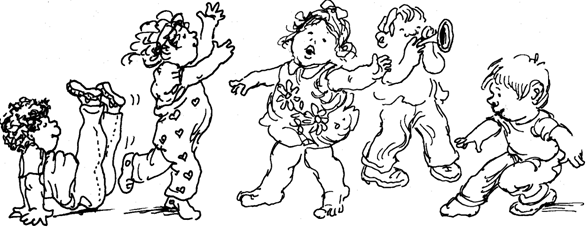
Six songs for supertots
You might be surprised to realize that you remember the tunes to all of these. Good! You can sing with your child when you're taking a walk, getting him or her ready for bed, riding in the car, and any other time you feel like it.
In case you've forgotten some of the words, here they are. Pretty soon your supertot will know them too.
I'm Little Teapot
I'm a little teapot
Short and stout;
Here is my handle, [Put arm on hip.]
Here is my spout. [Bend other arm up.]
When I'm ready,
Then I shout,
Tip me over [Bend to the side.]
And pour me out.
Ring Around the Rosie
Ring around the rosie,
A pocket full of posies,
Ashes, ashes,
All fall down!
[Join hands and walk around in a circle, falling down at the end.]
Row, Row, Row Your Boat
Row, row, row your boat
Gently down the stream;
Merrily, merrily,
Merrily, merrily,
Life is but a dream.
[Imitating rowing motions with your arms, while sitting on the floor,
as in a boat.]
Twinkle, Twinkle, Little Star
Twinkle, twinkle,
Little star,
How I wonder
What you are.
Up above the
World so high,
Like a diamond
In the sky;
Twinkle, twinkle,
Little star,
How I wonder
What you are.
Jingle Bells
Jingle bells, jingle bells,
Jingle all the way;
Oh, what fun
It is to ride
In a one-horse open sleigh. Hey!
Jingle bells, jingle bells,
Jingle all the way;
Oh, what fun
It is to ride
In a one-horse open sleigh.
[It's fun to shake bells when you sing this.]
If You’re Happy and You Know It
If you're happy and you know it,
Clap your hands. [Clap, clap.]
If you're happy and you know it,
Clap your hands. [Clap, clap.]
If you're happy and you know it,
Then your face will surely show it,
If you're happy and you know it, Clap your hands. [Clap, clap.]
[Make up other verses with other actions: shake your head, touch your
nose, jump up and down, kick your feet, etc.]
Real musical instruments
Buying and collecting good rhythm instruments is an investment in pleasure and musical creativity for the whole family. Unlike pianos and violins, rhythm instruments are relatively inexpensive and do not require training to play. They can be played by both young and old; all that is required is a desire to explore sounds and make music.
One good rhythm band instrument given to a child each year on a birthday will add up over the years to a fine collection. Buy only rhythm instruments of the highest quality. In most cases, you can't find good instruments in discount stores, but you can find them in music stores or order them from the companies that sell them to schools.
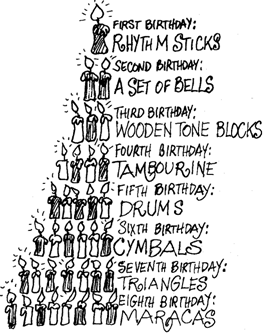
Keep the instruments in a special place, perhaps an old chest or up high on a bookshelf. Don't leave them around like toys. Teach your child to use them with respect; when you're done, put them away carefully so they'll last a long time.
Improvising Musical Instruments
When to have a noisy bash with improvised musical instruments: at birthday parties, on rainy days when your child's energy can no longer be contained, when you feel like a parade, and when the whole family feels like letting go together.
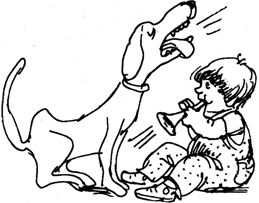
Instruments to improvise are all around you:
1 wooden salad bowl turned upside down, or 1 spaghetti pot turned upside down = 1 drum
1 cardboard paper towel roll, or 1 cardboard toilet paper roll = 1 horn
1 ring of metal or plastic measuring spoons = 1 shaker
1 plastic container filled with small things and closed with a tight lid = 1 rattle
Hint: Too much noise may scare small children and give you a headache, so try to maintain a steady, quiet rhythm with your instrument while your child contributes bursts of cacophony. Singing or chanting may give a sense of direction to the noise and may even turn it into music. Marching is another way to provide a sense of musical purpose.
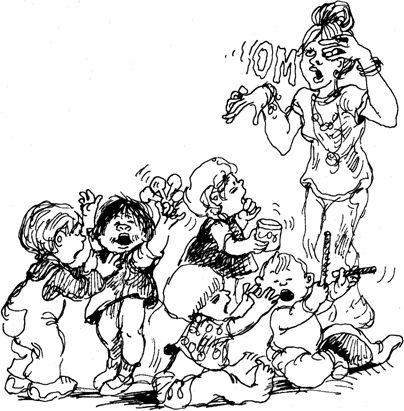
Dancing together
Musical Toy Game
Save a musical crib toy for dancing. Let your child hold it and make it go by him- or herself. When the music plays, dance. When it stops, stop dancing.
Mirror Dance Dance and sing together in front of a full-length mirror. It's fun!
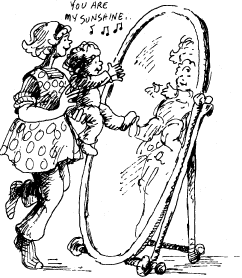
Exercise Dance
Make up a series of simple exercises that are good for you and simple enough for your child to more or less do with you. The simpler the chant that goes with them, the better. A five-minute routine is about all most supertots can handle.
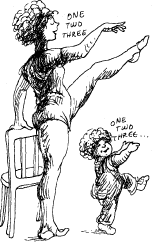
Happy Sad Mad Dance
Short expressive "dances" help your child identify emotions and learn how to express and share them. A fifteen
second mad dance can let off steam and find itself turning into a laughing dance.
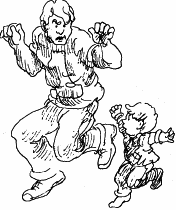
|

